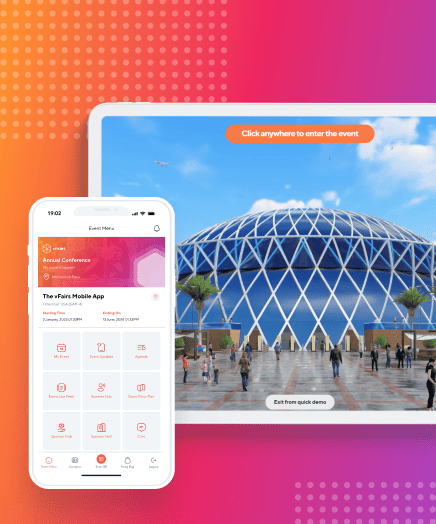Since the emergence of COVID-19, all events and activities requiring people to gather in one space is impossible. In such unprecedented circumstances, when students have to decide which university to attend, a virtual education fair platform is their answer! A range of universities all under one virtual roof!
In a physical education fair, students and parents can engage with prospective universities. They can talk to representatives, gather information about the university, its programs, faculty and even financial aid programs. Similarly, in a virtual education fair, universities can chat with prospective students, disseminate valuable information, and capture high quality leads.
According to a global higher education consultancy, QS Quacquarelli Symonds, 46% of prospective international students intend to defer their admission by a year due to the ongoing pandemic.

With the chaos caused by COVID, a virtual education fair is an indispensable solution that offers the opportunities to both universities and students. Students can network and chat with university representatives, counsellors, and current students, and universities can connect with students from around the globe at the virtual education fair.
Additionally, students don’t have to carry huge amounts of flyers, brochures and program books, and neither do universities have to print these and incur extra costs. They can download only the ones they want.
With that being said, keeping your audience engaged in a virtual education fair is critical. The exhibitors (universities) have to ensure that the attendees (students and parents) are fully involved. They also have to do their best to ensure that attendees receive all the information that they need to make an informed decision.
For this, hosts and exhibitors must share relevant content on their virtual events platform. This content needs to keep the attendees engaged, informed, and inevitably help them in making that difficult decision of which university to attend.
Let’s explore the type of content that you should make available at your virtual education fair.
WELCOMING ATTENDEES!
Your lobby is the first place that the attendees virtually ‘step’ into. Making sure the lobby is fun and exciting is important. If greeted by a dull lobby, attendees might lose interest. In addition to making the lobby design appealing, you can share content that would make attendees feel comfortable in this virtual setting.
For instance, placing a welcome video right at the front and center of your lobby would allow attendees to make their first human interaction at the virtual education fair. This video could set the stage for the rest of the event, allowing attendees to understand what to expect.
Moreover, the agenda and a virtual platform tutorial could help the attendees navigate through the virtual venue. The agenda would lay out the schedule for the entire day, and the tutorial would guide them through the virtual platform.

ACCESSIBLE AND EASY TO DOWNLOAD MATERIAL
Providing downloadable resources can help your attendees remember what each school has to offer. They can save documents in a virtual ‘swag bag’ and view them later. There are two types of support material you can add to your virtual education fair:
Documents
These can include a variety of support materials that compliment the universities’ promotional efforts and provide content that adds value to the students’ university application process. From steps to follow, to checklists and entry requirements, include any documents that would ensure students are not missing out on important steps in their application journey.
Brochures and flyers about each university provide quick bite-sized information about all the university has to offer. Since there are a lot of universities displaying their programs, easy to understand content which highlights key offerings at a glance would help not just students and parents, but the university itself in standing out.
For greater details, undergraduate and graduate program books that go over each and every degree program and course the university offers could also be made available online and linked through their booths.

Videos
A video vault can let students get more information in the virtual education fair. For instance, short videos such as student success stories or student experiences can be added to give prospective students an understanding of what various universities have to offer.
Even housing tours and campus tours could be added into this video vault. Students could get an immersive experience by going through the university they will be spending a majority of their time at in the coming years. Looking at sports facilities, auditoriums, recreational spaces, and housing could help students make their decision on where to go.
ENGAGING UNIVERSITY BOOTHS IN VIRTUAL EDUCATION FAIR
Exhibitor booths are a key area where universities can interact with prospective students and make their first impressions on the students in this virtual venue. Well branded and customized booths that appear attractive are essential to grab attendee’s attention. The booths must also have information that answers the attendees’ questions and helps them in their decision making process.
Information about the number of campuses the university has, descriptions of the university and its heritage, and links that direct them to the university’s website or social media pages will let attendees explore further and know more about them.
Key downloadable support material could also be added, such as details of undergraduate and graduate degrees, program structure, course outlines, and some helpful maps that would let students dive into the campus — albeit virtually.

INTERACTIVE WEBINAR SESSIONS
Webinars can be hosted in a virtual auditorium, and are a great way to keep your attendees engaged. Hosts have an option to host on-demand, live or pre-recorded sessions. These sessions can focus on applying for financial aid, how to apply and write winning essays, and even key deadlines and processes. On-demand sessions can be available to play or view whenever the attendee wants.

INCLUDE GAMIFICATION TO KEEP THINGS INTERESTING
To ensure maximum interaction and engagement between students and university exhibitors, the host can also make use of the gamification feature offered by vFairs. Either through a leaderboard or a scavenger hunt, they can encourage attendees to visit specific areas and complete tasks throughout the virtual venue.
Every time an attendee goes to a webinar session, downloads any support material, views videos in the video vault, or even chats with university representatives in the chat room they can earn points.
These will encourage attendees to partake in as many activities as they can, as winning will earn them prizes and maybe even scholarships!
KEY TAKEAWAYS
- Welcome attendees to help them understand the virtual space they are entering, helping them breeze through the event.
- Add documents and videos as support materials that students can download, and reference later.
- Provide links to school websites and social media pages to allow prospective students to experience more of the university.
- Add webinars on important topics that would help students in their university application process.
- Add incentives, and use gamification to keep students interested.


